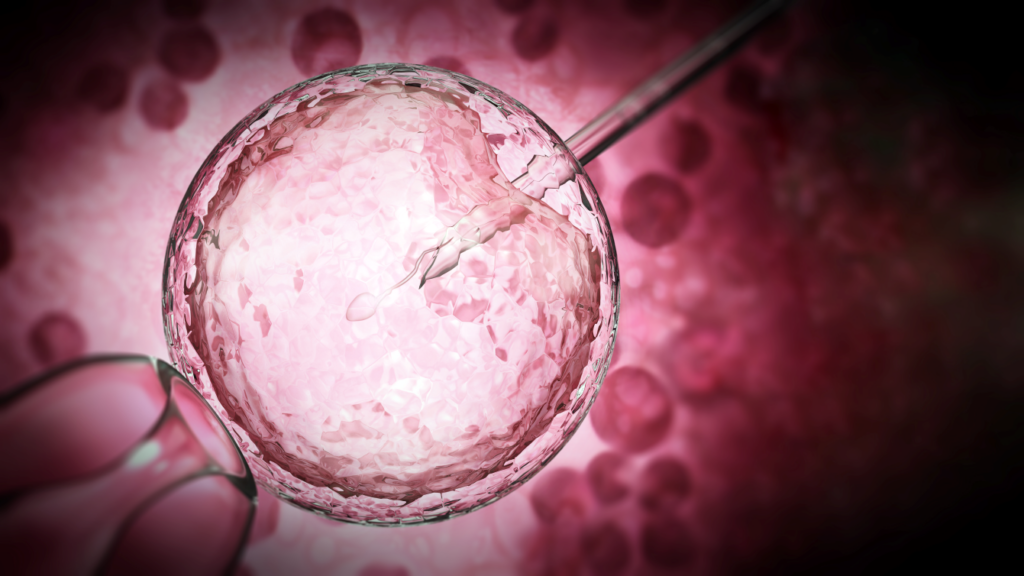The Molecular Science of Making Babies
Nobel Laureate Christiane Nüsslein-Volhard talks about embryology at the molecular level, connecting the development of fruit flies to that of vertebrates.
Published August 2, 2006
By Alan Dove
Academy Contributor
Sponsored by: Readers & Writers and Women Investigators Network
Cosponsored by: Goethe-Institut, Kales Press, and the German Book Office

Where do Babies Come From?
The question has unnerved parents for millennia. Even if you are completely comfortable discussing sex with someone barely out of potty training, there is a more fundamental pedagogical problem: you probably don’t really know the answer. Don’t feel bad. Until very recently, nobody did. Indeed, the problem of animal development—how an egg becomes a chicken, or a person, or a frog—has bedeviled scientists at least since Aristotle.
In the early 1970s, the molecular biology revolution finally started to reveal the fundamental mechanisms of heredity and physiology, but theories to explain development remained rudimentary.
“When you asked a chemist what they thought, they thought that in the egg there are molecules that are arranged in the pattern of the future mouse or whatever, and then this would somehow be … preformed in the egg, and then you asked how does this prepattern get into the egg, and they’d say ‘oh, yeah, there is a problem,'” says Christiane Nüsslein-Volhard, director of the Max Planck Institute for Developmental Biology. Unsatisfied with this answer thirty years ago, she decided to move developmental biology beyond this primitive understanding.
Nüsslein-Volhard spoke to a sellout crowd of more than 100 at the Goethe-Institut in New York City on June 8, 2006, as part of the Academy’s Readers & Writers seminar series. The event launched the English translation of her new book Coming to Life, which summarizes the astonishing progress scientists have made in understanding how genes drive development. Nüsslein-Volhard’s work, which earned her a Nobel Prize in Physiology or Medicine in 1995, is at the core of both the book and modern developmental biology.
Designing on the Fly
The first hint that molecules drive development came from another German, Hans Spemann, whose brilliant microsurgical manipulations of frog embryos demonstrated that special “organizing centers” in the embryo are capable of directing the development of specific structures. Grafting an organizer from the anterior end of one embryo onto another, for example, could produce a frog with two heads. After Spemann’s reports in the 1920s and ’30s, though, scientists were stumped for almost half a century. The organizer was obviously producing some kind of molecular signal that told how to build part of a frog, but nobody could isolate that signal biochemically.
Inspired by the success of fly geneticists in mapping traits to specific genes, Nüsslein-Volhard and her colleagues decided to use genetics to search for the organizing factors. Fruit flies, Drosophila melanogaster, have become such a fixture of developmental biology today that it is difficult to appreciate how revolutionary this idea was. Fly eggs are minuscule, and nobody thinks about looking for mutations that affect the developmental pattern.
Because the mutations they sought are rare, Nüsslein-Volhard and her colleagues had to screen vast numbers of eggs and larvae from mutagenized flies, looking for the tiniest differences between them. As an oblong fly egg develops into a maggot, it divides itself into segments lengthwise. Segments at one end will eventually develop into the structures of the head, and segments at the other become the abdomen. Something akin to Spemann’s organizers must direct this pattern.
Genome Mutations Lead to Defects
Nüsslein-Volhard and her colleagues eventually found that mutations in the fly genome can cause specific types of defects in this process. A mutant called knirps, for example, derailed the pattern in a specific zone of segments, while another, called even-skipped, affected alternating segments along the whole length of the larva, and a third, called hedgehog, affected all of the segments.
The researchers eventually determined that the fly body builds itself by following a programmed sequence of molecular signals encoded in the genome. In the early stage, a set of signals establishes general zones of the larva, corresponding to the future head, thorax, and abdomen. Then, each zone receives signals that subdivide it into more complex structures, like the mouthparts and eyes in the head.
To determine what types of structures to build, the cells of the embryo rely on gradients of the signals. For example, a signaling protein produced by cells at the anterior end will diffuse back toward the posterior end, fading like the signal of a radio station as one drives away from the transmitter tower. Cells of the future head will receive the signal clearly, triggering them to start building a head.
Where the anterior signal is weaker, cells will instead begin a thorax, and where the anterior signal is completely unreadable, the cells execute the abdomen-building procedure. A counter-gradient of signals from the posterior end has the opposite set of effects. Later in development, sub-gradients within each zone build the sub-structures within each major body segment.
Social Development
The fly work has become a cornerstone of modern developmental biology, and the book’s summary of it should make sense to most scientifically literate readers—with effort.
“It is complicated, I cannot help it,” Nüsslein-Volhard concedes, adding that “it is even simpler than you might have imagined, but there are some rules and there are genes and you have to … learn some vocabulary.” She points out that even a simple fly is far more complex than a computer or a car, so non-biologists hoping to understand development will have to brace themselves for a tough subject.
Many readers will undoubtedly skip directly to the final chapter of the book, which deals with current social controversies involving developmental biology. Though these subjects interest Nüsslein-Volhard far less than her laboratory work, she hopes to elevate the level of public discussion about issues like cloning, stem cell research, in vitro fertilization, and designer babies. The final chapter stems in part from her experience on the National Ethics Council of Germany, which she joined in 2001.
Though it is not mentioned in the book, Nüsslein-Volhard, one of only 12 women to receive a Nobel Prize in a scientific field, has another important project outside the lab. The Christiane Nüsslein-Volhard Foundation aims its money directly at one of the biggest problems facing women in science: child care.
Women qualify for the Foundation’s grants primarily on the quality of their scientific work, but the money can be used for a range of household expenses, addressing what some studies euphemistically call the “work-family balance.”
Fishing for Answers
Meanwhile, Nüsslein-Volhard still heads a large, productive laboratory that remains on the leading edge of developmental biology. Having worked out the fundamental processes of fly development in the 1970s and ’80s, the group next began to explore vertebrate development, using the common aquarium zebrafish Danio rerio as a model organism.
“I started working with fish because I thought … it’s nice to know how flies develop, but can we deduce anything for other organisms from it? Maybe it’s totally different in frogs or in fishes,” says Nüsslein-Volhard. The small, fast-breeding zebrafish develop inside transparent eggs, making them ideal for the same type of analysis that had worked so well in flies: a large-scale genetic screen for developmental signals.
There were reasons to hope that flies and fish might share at least some of the basic mechanisms of development. Besides the general tendency of evolution to conserve useful functions, there were also some old observations from comparative anatomy and taxonomy that suggested strong parallels between vertebrate and invertebrate body plans.
Very early in the development of any animal, the ball of dividing embryonic cells undergoes gastrulation, forming the initial opening of the gut. In protostomes, a large and diverse category of animals that includes arthropods, this initial opening becomes the mouth. In deuterostomes, the group that includes vertebrates, the initial opening becomes the anus. This head-to-tail mirroring prefigures the rest of the developmental plan.
For example, a lobster’s heart is dorsal, up in its shoulders, while a cat’s heart is ventral, down in its chest. Though it seems like a major anatomical difference, this is simply the outcome of switching gastrulation from one end to the other. The adult forms are very different, but in the earliest stages of development, a cat is just an upside-down lobster.
Anatomic Inversions at the Molecular Level
By screening thousands of mutagenized fish for developmental defects, Nüsslein-Volhard and her colleagues found that this anatomic inversion also holds true at the molecular level. The signals that mark the dorsal side of a fly embryo have homologues in fish, but the fish versions mark the ventral side of the embryo. The evolutionary recycling continues in later stages of development, with vertebrates and invertebrates using the same genes and signaling strategies to produce radically different forms and structures.
Besides covering Nüsslein-Volhard’s own work, Coming to Life puts the results into the general context of molecular biology and embryology. Helpful introductory chapters guide a general reader through basic genetics, cell biology, and biochemistry, and the findings from flies and fish accompany related results from other organisms, including humans. Throughout this thin but thorough volume, the author’s own line drawings provide clear illustrations of the main concepts. Sections on the burgeoning field of evolutionary development and exciting recent results on human origins round out the story.
For biologists, the book is a useful refresher of concepts they forgot or missed in a basic embryology course, and for students and the scientifically curious, it is a solid introduction to the topic. Parents of inquisitive preschoolers may still want to invoke storks, baskets, or Sears to explain where babies come from, but at least scientists now have much more detailed answers about embryonic origins and development. We’ve certainly been asking long enough.
About the Author
Christiane Nüsslein-Volhard, PhD, is the director of the Max Planck Institute for Developmental Biology in Tübingen and also leads its genetics department. She graduated from Tübingen University with a degree in biochemistry in 1968 and earned her PhD there in 1973. Nüsslein-Volhard then began her investigation of Drosophila and conducted a large-scale mutagenesis study of embryonic development of the fruit fly that provided insights into genes involved in development. The findings also showed that protostomes and deuterostomes probably have a common ancestor with a complex body plan. Moreover, the results of the study were helpful in understanding the regulation of transcription and cell fate during development.
Together with Eric Wieschaus and Edward B. Lewis, Nüsslein-Volhard received the Nobel Prize in Physiology or Medicine in 1995 for research on the genetic control of embryonic development. Nüsslein-Volhard has also been honored with the Albert Lasker Award for Basic Medical Research and the Gottfried Wilhelm Leibniz Prize. She became a member of the Nationaler Ethikrat (National Ethics Council of Germany) for the ethical assessment of new developments in the life sciences and their influence on the individual and society.
Also read: Portrait of a Scientist and Mentor
